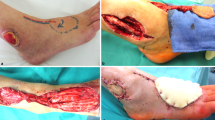Abstract
Background
Reverse sural flap (RSF) is commonly used for soft tissue reconstruction of distal leg and heel defects. The classic method of flap transfer is the single-staged cutaneous islanded reverse sural flap (SS-RSF). This method is associated with variable flap complications notably the venous congestion. The other form of flap transfer is the two-stage reverse sural flap (TS-RSF), in which the pedicle of the flap is exteriorized in the first stage. Flap division and re-inset are done in the second stage. The aim of this paper is to review the flap outcomes and complications among the SS-RSF and TS-RSF reconstruction of soft tissue defects in the distal leg and heel.
Methods
This is a retrospective chart review of RSF being operated in a tertiary care hospital. The duration of study was 1.5 years. Twelve RSFs (6 SS-RSF, 6 TS-RSF) were done for soft tissue defects in the distal leg and heel. Wounds of various etiologies (traumatic, chronic, non-healing ulcers) were reviewed. Trauma was the most common etiology with 8 out of 12 (66.7%) patients. Large wounds, donor site damage and patients with peripheral vascular disease were excluded from the study.
Results
Five out of six (83.3%) of TS-RSF healed uneventfully. However, 3 out of 6 (50%) of SS-RSF had partial flap necrosis. All complicated flaps healed well subsequently. No donor site complication was found in any of our patients.
Conclusion
Pedicle exteriorization in TS-RSF eliminates the element of venous congestion and eventually flaps necrosis. Less technical expertise and minimal morbidity are additional advantages of TS-RSF.
Level of evidence
Level IV, therapeutic study.




Similar content being viewed by others
References
Masquelet AC, Romana MC, Wolf G (1992) Skin island flaps supplied by the vascular axis of the sensitive superficial nerves: anatomic study and clinical experience in the leg. Plast Reconstr Surg 6(89):1115–1121
Ciofu RN, Zamfirescu DG, Popescu SA, Lascar I (2017) Reverse sural flap for ankle and heel soft tissues reconstruction. J Med Life 10(1):94–98
Almeida MF, da Costa PR, Okawa RY (2002) Reverse-flow island sural flap. Plast Reconstr Surg 109(2):583–591
Nazri MY, Sulong AF, Sulaiman WAW, Azril MA (2016) Acute vascular complications (flap necrosis and congestion) with one stage and two stage distally based sural flap for wound coverage around the ankle. Med J Malays 71(2):47–52
Angelats J, Albert LT (1984) Sural nerve neurocutaneous cross-foot flap. Ann Plast Surg 13(3):239–242
Olawoye OA, Ademola SA, Iyun K, Michael K, Oluwatosin O (2014) The reverse sural artery flap for the reconstruction of distal third of the leg and foot. Int Wound J 11(2):210–214
Follmar KE, Baccarani A, Baumeister SP, Levin LS, Erdmann D (2007) The distally based sural flap. Plast Reconstr Surg 119(6):138e–148e
de Rezende MR, Saito M, Paulos RG, Ribak S, Abarca Herrera AK, Cho AB, Mattar R Jr (2018) Reduction of morbidity with a reverse-flow sural flap: a two-stage technique. J Foot Ankle Surg 57(4):821–825
Kneser U, Bach AD, Polykandriotis E, Kopp J, Horch RE (2005) Delayed reverse sural flap for staged reconstruction of the foot and lower leg. Plast Reconstr Surg 116(7):1910–1917
Herlin C, Bekara F, Bertheuil N, Carloni R, Dast S, Sinna R, Chaput B (2017) Venous supercharging reduces complications and improves outcomes of distally based sural flaps. J Reconstr Microsurg 33(5):343–351
Maffi TR, Knoetgen J, Turner NS, Moran SL (2005) Enhanced survival using the distally based sural artery interpolation flap. Ann Plast Surg 54(3):302–305
Erdmann D, Levin S (2006) Delayed reverse sural flap for staged reconstruction of the foot and lower leg. Plast Reconstr Surg 118(2):571–572
Funding
No source of funding.
Author information
Authors and Affiliations
Corresponding author
Ethics declarations
Conflict of interest
The authors declare that they have no conflict of interest.
Ethical approval
Not taken as this is a retrospective chart review.
Informed consent
Informed consent was obtained from all individual participants included in the study.
Additional information
Publisher's Note
Springer Nature remains neutral with regard to jurisdictional claims in published maps and institutional affiliations.
Rights and permissions
About this article
Cite this article
Sahu, R.K., Kala, P.C. & Midya, M. Two-staged reverse sural flap: a versatile flap with consistent results in the soft tissue reconstruction of distal leg and heel defects—an institutional experience. Eur J Orthop Surg Traumatol 30, 337–341 (2020). https://doi.org/10.1007/s00590-019-02544-x
Received:
Accepted:
Published:
Issue Date:
DOI: https://doi.org/10.1007/s00590-019-02544-x




